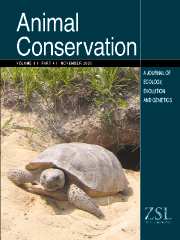Crossref Citations
This article has been cited by the following publications. This list is generated based on data provided by
Crossref.
O'Grady, Julian J.
Reed, David H.
Brook, Barry W.
and
Frankham, Richard
2004.
What are the best correlates of predicted extinction risk?.
Biological Conservation,
Vol. 118,
Issue. 4,
p.
513.
HARRIS, GRANT M.
and
PIMM, STUART L.
2004.
Bird Species' Tolerance of Secondary Forest Habitats and Its Effects on Extinction.
Conservation Biology,
Vol. 18,
Issue. 6,
p.
1607.
MANLEY, PATRICIA N.
SCHLESINGER, MATTHEW D.
ROTH, JULIE K.
VAN HORNE, BEATRICE
and
Vojta
2005.
A FIELD-BASED EVALUATION OF A PRESENCE–ABSENCE PROTOCOL FOR MONITORING ECOREGIONAL-SCALE BIODIVERSITY.
Journal of Wildlife Management,
Vol. 69,
Issue. 3,
p.
950.
Bomhard, Bastian
Richardson, David M.
Donaldson, John S.
Hughes, Greg O.
Midgley, Guy F.
Raimondo, Domitilla C.
Rebelo, Anthony G.
Rouget, Mathieu
and
Thuiller, Wilfried
2005.
Potential impacts of future land use and climate change on the Red List status of the Proteaceae in the Cape Floristic Region, South Africa.
Global Change Biology,
Vol. 11,
Issue. 9,
p.
1452.
Uezu, Alexandre
Metzger, Jean Paul
and
Vielliard, Jacques M.E.
2005.
Effects of structural and functional connectivity and patch size on the abundance of seven Atlantic Forest bird species.
Biological Conservation,
Vol. 123,
Issue. 4,
p.
507.
Jones, Martin J.
Fielding, Alan
and
Sullivan, Matthew
2006.
Analysing Extinction Risk in Parrots using Decision Trees.
Biodiversity and Conservation,
Vol. 15,
Issue. 6,
p.
1993.
SIGEL, BRYAN J.
SHERRY, THOMAS W.
and
YOUNG, BRUCE E.
2006.
Avian Community Response to Lowland Tropical Rainforest Isolation: 40 Years of Change at La Selva Biological Station, Costa Rica.
Conservation Biology,
Vol. 20,
Issue. 1,
p.
111.
Angel, A.
Branch, G.M.
Wanless, R.M.
and
Siebert, T.
2006.
Causes of rarity and range restriction of an endangered, endemic limpet, Siphonaria compressa.
Journal of Experimental Marine Biology and Ecology,
Vol. 330,
Issue. 1,
p.
245.
Cofre, Hernán L.
Böhning‐Gaese, Katrin
and
Marquet, Pablo A.
2007.
Rarity in Chilean forest birds: which ecological and life‐history traits matter?.
Diversity and Distributions,
Vol. 13,
Issue. 2,
p.
203.
Pimm, Stuart L.
2008.
Biodiversity: Climate Change or Habitat Loss — Which Will Kill More Species?.
Current Biology,
Vol. 18,
Issue. 3,
p.
R117.
VALE, MARIANA M.
COHN‐HAFT, MARIO
BERGEN, SCOTT
and
PIMM, STUART L.
2008.
Effects of Future Infrastructure Development on Threat Status and Occurrence of Amazonian Birds.
Conservation Biology,
Vol. 22,
Issue. 4,
p.
1006.
SEKERCIOGLU, CAGAN H.
SCHNEIDER, STEPHEN H.
FAY, JOHN P.
and
LOARIE, SCOTT R.
2008.
Climate Change, Elevational Range Shifts, and Bird Extinctions.
Conservation Biology,
Vol. 22,
Issue. 1,
p.
140.
Roediger, Lana M.
and
Bolton, Toby F.
2008.
Abundance and distribution of South Australia's endemic sea star, Parvulastra parvivipara (Asteroidea: Asterinidae).
Marine and Freshwater Research,
Vol. 59,
Issue. 3,
p.
205.
JENKINS, CLINTON N.
and
GIRI, CHANDRA
2008.
Protection of Mammal Diversity in Central America.
Conservation Biology,
Vol. 22,
Issue. 4,
p.
1037.
HARRIS, GRANT
and
PIMM, STUART L.
2008.
Range Size and Extinction Risk in Forest Birds.
Conservation Biology,
Vol. 22,
Issue. 1,
p.
163.
Wilson, G
Branch, G M
and
de Coito, P
2009.
Comparative salinity tolerances of four siphonariid limpets in relation to habitat restriction of the rare and endangeredSiphonaria compressa.
African Journal of Marine Science,
Vol. 31,
Issue. 3,
p.
311.
Pimm, Stuart L.
2009.
Climate Disruption and Biodiversity.
Current Biology,
Vol. 19,
Issue. 14,
p.
R595.
HOCKEY, PHILIP A. R.
and
CURTIS, ODETTE E.
2009.
Use of Basic Biological Information for Rapid Prediction of the Response of Species to Habitat Loss.
Conservation Biology,
Vol. 23,
Issue. 1,
p.
64.
Isaac, Joanne L.
Vanderwal, Jeremy
Johnson, Christopher N.
and
Williams, Stephen E.
2009.
Resistance and resilience: quantifying relative extinction risk in a diverse assemblage of Australian tropical rainforest vertebrates.
Diversity and Distributions,
Vol. 15,
Issue. 2,
p.
280.
Fattorini, Simone
2010.
Biotope prioritisation in the Central Apennines (Italy): species rarity and cross-taxon congruence.
Biodiversity and Conservation,
Vol. 19,
Issue. 12,
p.
3413.


